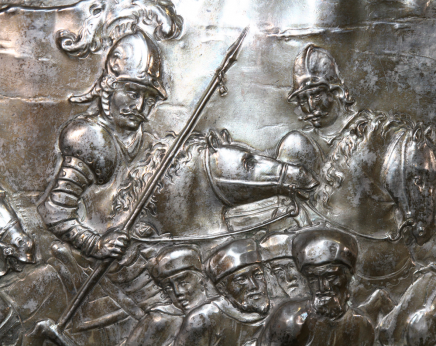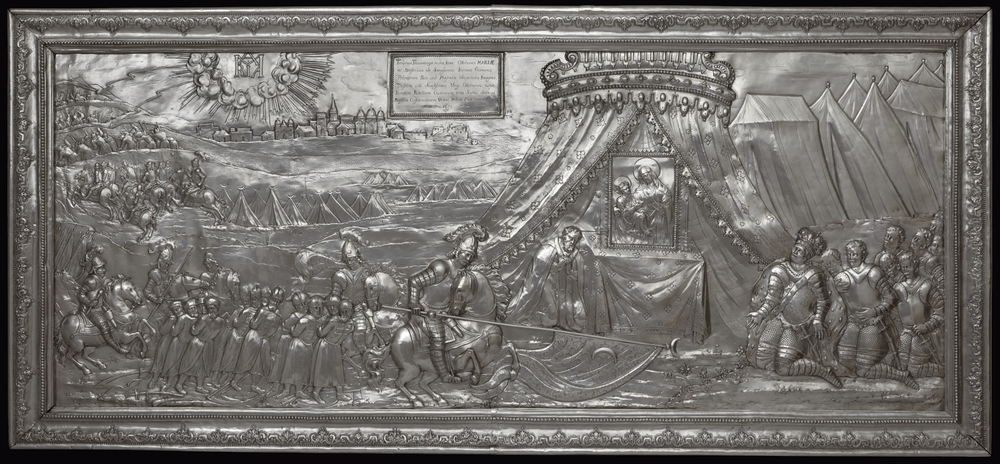MNK The Ciołek
ul. Kanonicza 17, 31-002 Kraków- Monday: closed
- Tuesday: 10.00-18.00
- wednesday-sunday: 10.00-16.00
Information and reservations on weekdays 9 a.m.- 4 p.m.
The Director of the National Museum in Krakow
Deputy Director for Programme Activity
Deputy Director for Strategy and Communications
Deputy director for the Management
Chief Accountant
Chief Cataloguer of the National Museum in Krakow
Chief Conservator

Antependium is a decorative panel placed beneath an altar table (mensa). The silver antependium from the collegiate church in Chelm is the only remaining piece of the baroque furnishing of the temple. Until 1874 the church was a cathedral of the orthodox dioecese that was united with Roman catholic church.
In 1596. The old church was demolished in the 18th century and replaced by a late Baroque one, designed by Italian architect Paolo Fontana. The new building was ready by 1756. During the partition of Poland in the 19th c. the religious union with papal Rome was breached by the Russian tsar, and the cathedral became an orthodox church. The building and its furnishing was altered in Russian style, and the antependium was sent to the Kremlin Armoury in Moscow. It has been restituted in 1923 as a result of Polish victorious war with Soviet Russia and the Peace of Riga (1921).
The former orthodox cathedral in Chelm is a place where the Byzantine icon of Our Lady, painted in the 12th c., was venerated from the time unknown. It is a representation in the Hodegetria type, known as Dexiokratousa which means that Mary holds Jesus on the right hand. In the old Poland it was one of the most renowned holy images. In 1765 it was crowned with papal crowns that were sent in from Rome. After the WWII the icon was taken from Chelm to Ukraine and hidden for half a century. It was not revealed until the fall of the Soviet Union. Now the painting remains in Luck.
Our Lady of Chelm was famous not only for numerous miracles that were granted to the faithful in the sanctuary but also for the role in the Khmelnytsky Uprising. In 1651 king John Carimir took it to his war camp at Berestechko. The battle that took place there in June 28-30 was one of the biggest in the history of early modern Europe. Poles rendered victory over united forces of Kossacks and Tartars. A siege of the fortified enemy camp begun. On July 10 panic broke among the Cossacks and they started to flee through marshland. Many drowned, the rest was massacred. The number of the fallen is estimated at 30 thousand.
The Polish army thanked Our Lady of Chelm for protection and the victory. The antependium shows the king on his knees, the soldiers present their tropy, the standard of Muslim Tartars. The resigned captives accept their defeat. The rest of the enemy army escapes through the wetland chased by Polish raiders and by thunderbolts from clouds where the symbol MARIA appears.
The author of this exceptional work was Johann Jöde (active 1707-1743), a goldsmith from Gdansk. He is known for about 30 silver pieces: vessels, utensils, paraments decorated with Regency ornamentation. The antependium from Chelm is one the best items in his oeuvre.
curator of the exhibition: dr Tomasz Zaucha
cooperation: Alicja Kilijańska, dr hab. Mirosław P. Kruk
exhibition coordinator: Anna Sobesto
exhibition design: Ewa Morzyniec
